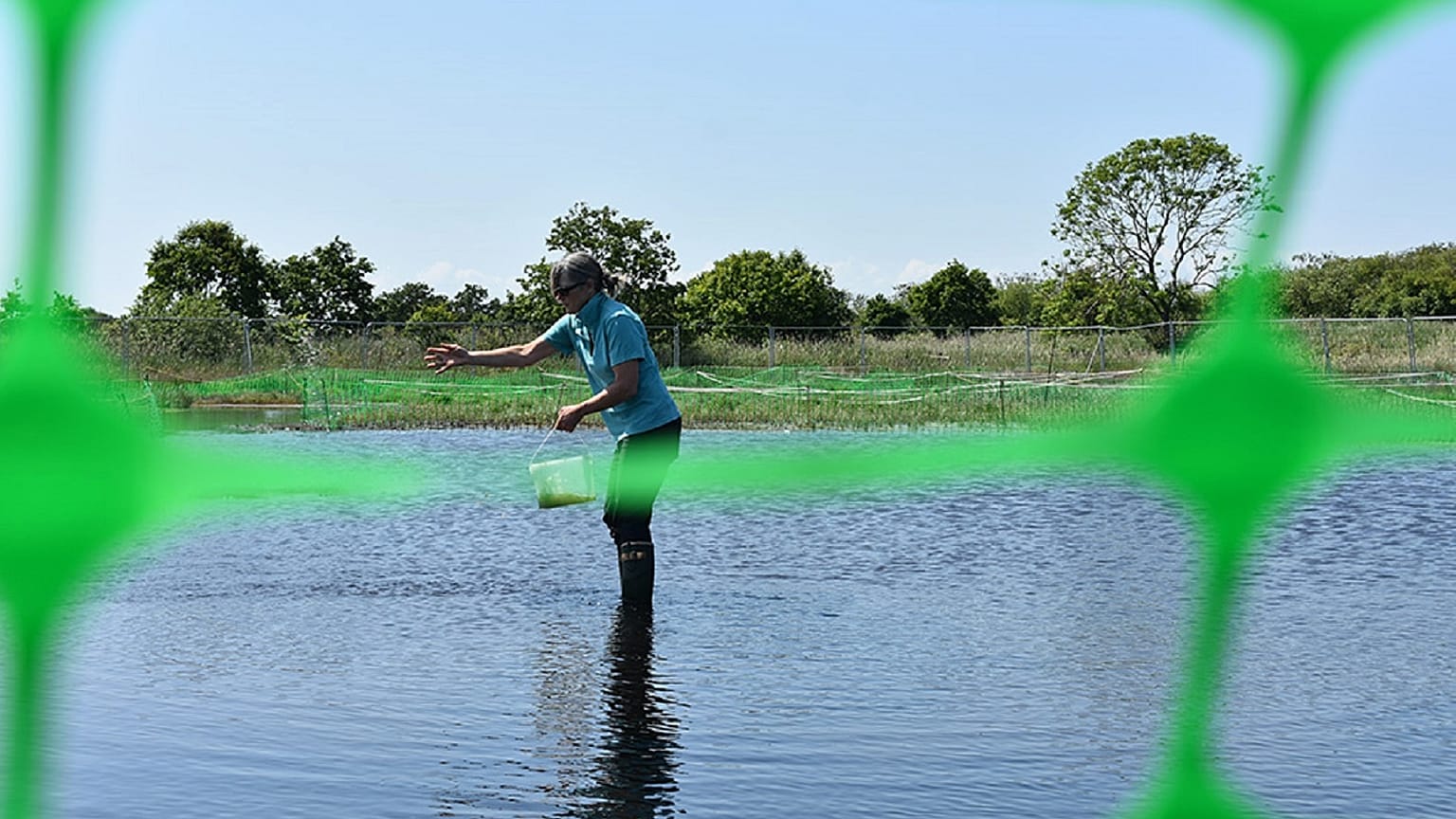Rewetting drained land could help in the fight against climate change but the EU's agricultural subsidies scheme currently favours the use of drained land.
Dutch farmer Aldert van Weeran plucked a thick stalk of bright green sweet grass from his flooded field. For most farmers in Europe, a field saturated with water at surface level would spell disaster, but Van Weeran was delighted with the mud.
In 2020, he rewet 1.5 hectares of drained peatland situated just outside Amsterdam and started a type of wetland farming known as paludiculture. Van Weeran’s crop, a species of Typha, has flourished.
But as experts around the world call to rewet drained wetlands to absorb greenhouse gases, restore biodiversity and provide ecosystem services, a serious question looms: What happens to millions of other farmers who make their living from drained land?
“Paludiculture is the solution to multiple problems,” said van Weeran, who sells the Typha to a building company for insulation materials as well as the carbon credits his expanding farm produces.
Van Weeran is part of a small, experimental but growing movement of European farmers, researchers and business owners from Estonia to Ireland working to turn paludiculture into a feasible alternative to farming drained wetlands, but they face a dense web of regulatory and cultural obstacles.
Why wetlands matter in the fight against climate change
A February 2023 study in the journal Nature estimated that, globally, 21% of inland wetlands have been lost in the last 300 years, predominantly due to drainage for agriculture, with the biggest losses in China, the United States and Europe. A team from the University of Exeter found that 40 billion tons of carbon have been released from drained wetlands in the Northern Hemisphere since 1750.
Portions of Europe’s bogs and fens have been drained for a thousand years to harvest carbon-rich peat – plant material that has partly decayed underwater for millennia – for fuel. But research has shown that in the 20th century, agricultural mechanisation, government subsidies and a growing population increased the speed of Europe’s peatland drainage dramatically.
The Nature report revealed that the United Kingdom has drained about 75% of its wetlands while The Netherlands has lost more than 70% for farmland and development. Sweden, Finland and Estonia have lost more than 45% of their wetlands to forestry alone.
“Presently, drained peatlands constitute about 10% of Estonia’s total emissions,” Jüri-Ott Salm, wetlands programme coordinator with the Estonian Fund for Nature, told Euronews.
“If we would like to achieve carbon neutrality, to decrease these emissions, then one way ahead is paludiculture,” he said, though added, “the main challenge is to turn drained peatlands back to wetlands and to manage them with paludiculture.”
Draining peatland releases carbon dioxide and nitrogen oxides, gases that contribute to climate change. And in a summer when Europe has been plagued alternately with severe droughts and devastating flooding, advocates of rewetting these vast regions say there is ample reason.
Wetlands control flooding, filter toxic chemicals from water, aid groundwater retention, boost drought resilience, enable biodiversity and habitat expansion, and act as enormous carbon sinks.
But researchers are still met with resistance from farmers who have cultivated drained peatland for generations.
“We do need more research on the emotional psychological aspects of this, especially in those areas where the farmland was in the family for a very long time,” said Anke Nordt, a peatlands researcher at the Greifswald Mire Centre in northeastern Germany.
“[Farmers] say, ‘I would do it, but I can’t rewet because my ancestors put so much effort in draining it,’” she said.
More often, though, experts from across Europe told Euronews, the strongest objections are far more practical.
EU agriculture subsidies benefiting drained land
Until this year, the EU’s common agricultural policy (CAP) excluded from subsidy payments paludiculture crops such as Typha, peat moss, reed, and cattail while heavily subsidising livestock and arable farming on drained peatland for decades.
The new CAP, which took effect in January, includes paludiculture but left implementation of payment schemes to member states, creating uncertainty and a potential patchwork of regulation, while still incentivising agriculture on drained land.
Early adopters of paludiculture say those incentives must end for wetland farming to take root.
“We have to look for the polluters pay principle,” said Jens-Uwe Holthuis, project manager at Sphagnumfarm Barver, a peat moss, or sphagnum, paludiculture demonstration site in Lower Saxony, Germany.
Holthuis explained that when farmers drain land and release greenhouse gases, it is the public who pays the price of climate impacts.
“Farmers who are draining their land have to pay or have to lose the subsidies they are getting for draining the land,” Holthuis said.
Even if direct payments to those growers ended, there are still major hurdles to overcome. Longstanding land use laws, individual land rights, upfront costs and developing markets for paludiculture products will all need careful attention, researchers say. In some countries, water rights are particularly contentious.
In Britain under recent reforms, the Environment Agency has rescinded some water abstraction licenses of farmers working on drained land.
“We need a different system of water judgement for peatlands,” said Andrea Kelly, an environmental policy adviser with the Broads Authority in East Anglia, England. Kelly manages several wetlands restoration projects including a paludiculture site.
“The peat can’t be moved. The water can. So if we want to deliver net-zero through peatlands … if our farming, as a sector, want to get hold of that [opportunity] then they need to be enabled, and the only way is to deliver the water,” she told Euronews.
Governments start rewetting programmes
As enthusiastic as paludiculture pioneers are, all agree that for farmers to achieve a just transition into wetland cultivation, market economics must also scale up considerably. The avant-garde remains optimistic, if pragmatic, and points to multiple industries that are already incorporating paludiculture crops in manufacturing.
Typha is used in building materials and insulation, paper, food in high-end restaurants, and in animal feed. The most well-known product, reed, has been used in traditional thatched roofs for centuries.
Clothing maker saltyco uses cattail fibers in its insulated cloth, and sphagnum supplier BeadaMoss is developing a peat moss alternative to extracting raw peat, which currently underpins the multibillion euro global horticulture industry as a planting medium.
Researchers say that sales revenue combined with appropriate agricultural subsidies, ecosystem services and carbon sequestration payments could provide a livelihood at least as stable as many farmers on drained lands have now, but without the cost of feed, fertilizer, or environmental damage.
With net-zero commitments in mind, individual governments have begun to take notice.
Germany has invested up to €150 million in two 10-year paludiculture projects comprising at least 10 sites. England last year earmarked £5 million (€5.85 million) for paludiculture grants and awarded 12 projects funding in June.
For Aldert van Weeran, approaching his second Typha harvest, the equation is simple.
In the end, he said, ecologically “the math is about destroying, or rebuilding.”















